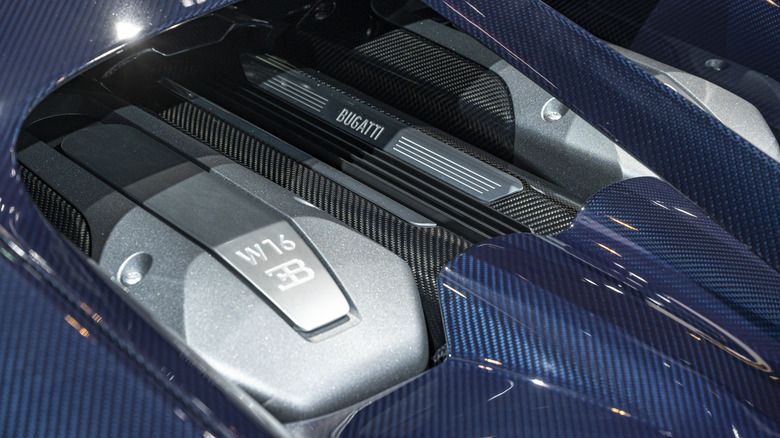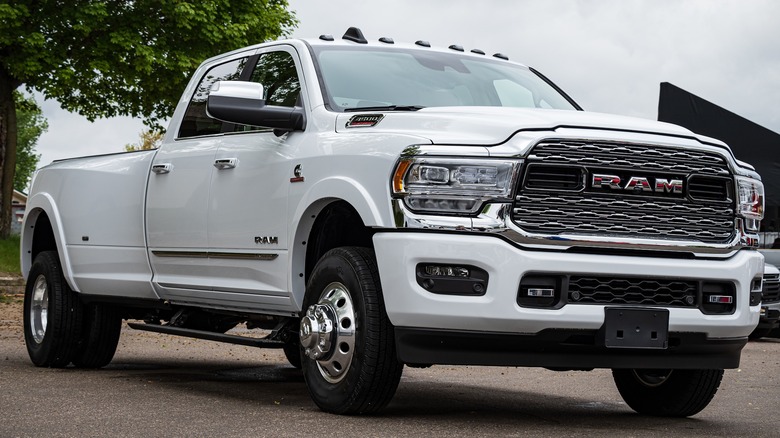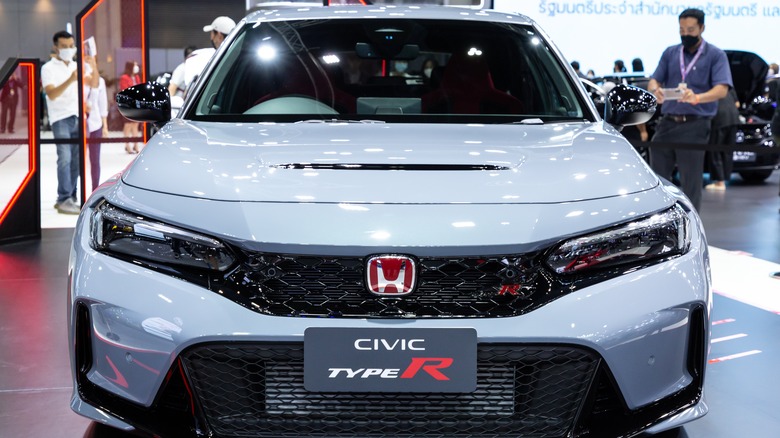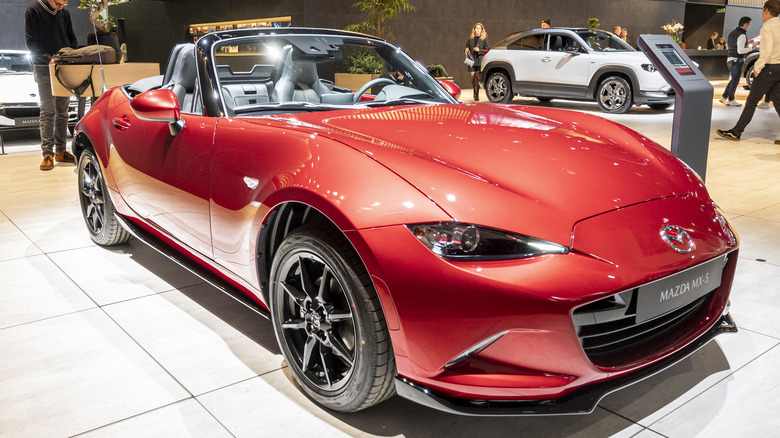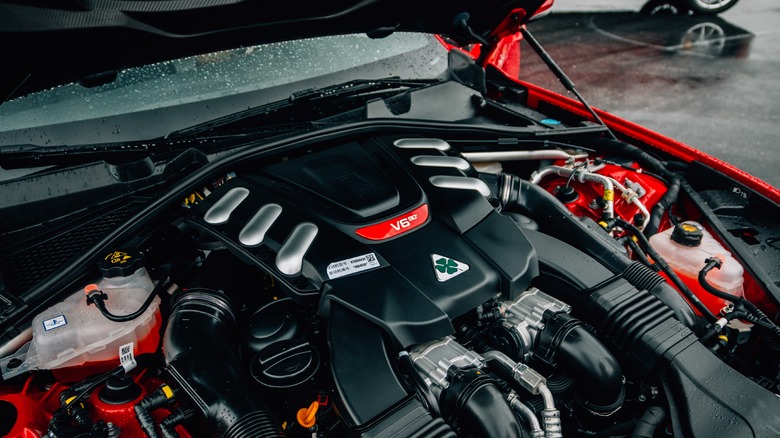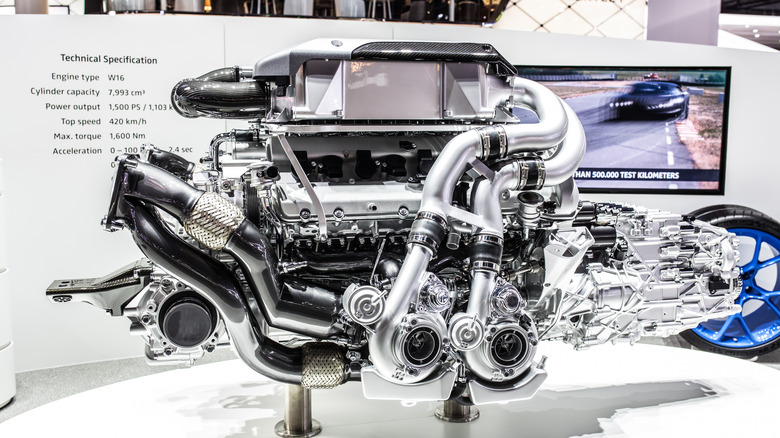5 Of The Best Engines You Can Get In A New Car
Most new car buyers prioritize safety features, fuel economy, and build quality over the MSRP and design. But for hardcore car enthusiasts, what's under the hood matters most next to the design and the vehicle model's lineage. There's a reason why South Korean automaker Hyundai is prepping its incoming Ioniq 5 N, the race-prepped variant of the angular Ioniq 5 EV crossover, with a slew of internal combustion-inspired components like virtual jet fighter sounds and an innovative one-speed transmission with virtual gears: To make EVs as engaging to drive as their gasoline-fed grandparents.
And while electrification is creeping over a once-dominant ICE landscape, the good old gasoline engine has become more powerful, efficient, and cleaner with the influx of new material technologies, forced induction, and tuning techniques. Undoubtedly, the engine is the heart of any internal combustion vehicle, and here are five of the best you can get in today's new cars.
Ram 3500 Cummins 6.7-liter turbo-diesel
Buyers have two engine choices when choosing a Ram 3500 heavy-duty truck. The standard gas engine is a 6.4-liter gasoline V8 with 410 horsepower and 429 pound-feet of torque. However, the optional 6.7-liter Cummins inline-six turbo-diesel has up to 420 horsepower and 1,075 pound-feet of torque, perfect when towing up to 37,100 pounds. Compared to the 5.9-liter Cummins diesel from older Ram trucks, the new diesel mill is lighter, smoother, and more fuel efficient thanks to a variable geometry turbocharger.
The Ram 3500 is available in three cab body styles, a standard or an extended bed, and a comfy cabin loaded with advanced tech like an 8.4-inch infotainment touchscreen, smartphone connectivity, dual-zone automatic climate control, a heated tiller, power seats, and a heated steering wheel. Furthermore, the Ram 3500's exclusive Cummins 6.7-liter diesel could be the best commercial diesel engine you can buy today. It's not hard to imagine the things you can do with 1,075 pound-feet of torque.
Honda Civic Type R 2.0-liter turbo engine
The next-gen Honda Civic Type R debuted in 2022 and featured a reworked version of the K20C1 turbocharged engine from the previous FK8 Civic Type R. The changes include a revised and more compact turbocharger with optimized turbine blades, a lightweight forged-steel crankshaft, an aluminum block, and innovative F1-style cooling jets to reduce the temperature of the piston rings.
The result is a Civic Type R with 306 horsepower and 295 pound-feet of torque, with the latter available from 2,500 to 4,500 rpm. And since we're talking about a Honda, the new 2.0-liter turbo engine could rev to 7,000 rpm with 23.2 psi of boost. Viewed differently, the Honda Civic Type R has more power than the old-school Honda/Acura NSX supercar with a naturally-aspirated V6, and it's quicker, too. The Type R blasts from zero to 60 mph in 5.3 seconds and destroys the quarter mile in 13.9 seconds, whereas the NSX sprints from zero to hero in 5.7 seconds.
Mazda MX-5 2.0-liter Skyactiv-G gas engine
The Mazda MX-5, in any iteration, proves you don't need massive horsepower to have fun. Mazda unveiled the ND MX-5 in 2015 with a 155-horsepower 2.0-liter naturally-aspirated Skyactiv-G gasoline engine. But in 2019, Mazda engineers had a rethink: Why not make the engine lighter and more powerful? So they did.
In came lighter pistons, connecting rods, a larger-diameter throttle body, bigger exhaust valves with more comprehensive ports, and a lift mechanism on the exhaust camshaft. The changes increased the engine's redline to a screaming 7,500 rpm, producing 181 horsepower and 151 pound-feet of torque. The numbers are nowhere near the Civic Type R's, but the MX-5 is not a fire-breathing track monster. Instead, it's a drop-top coupe for Sunday drives around curvy mountain roads, relishing the vehicle's telepathic responses around corners. For that, the 2.0-liter Skyactic-G fits the bill to a T with its modest power and torque outputs and rev-happy nature.
Alfa Romeo Giulia & Stelvio Quadrifoglio 2.9-liter twin-turbo V6
The Giulia Quadrifoglio (and its crossover sibling, the Stelvio Quadrifogflio) belongs to our list of the best Alfa Romeos, but not for its handsome styling and stellar handling. It all concerns its Ferrari-derived 2.9-liter twin-turbocharged V6 engine, a stellar power unit with 505 horsepower and 443 pound-feet of torque. In addition, it spins to an exceptional 7,000 rpm while producing the burbly sounds of a high-strung V8 engine from Maranello.
With such a spirited gas engine, it's no wonder that the Giulia Quadrifoglio could effortlessly lap the Nurburgring in 7 minutes and 39 seconds while rushing from zero to 60 mph in 3.9 seconds. Meanwhile, it has a 191 mph top speed. The 2.9-liter twin-turbo V6 is the most powerful engine in a production Alfa Romeo and has direct fuel injection, double overhead cams, 24 valves, aluminum blocks and heads, and a 9.3:1 compression ratio. The good news is you get the same engine in a Stelvio Quadrifoglio, but beware that Alfas depreciate faster than any Euro or Japanese car.
Bugatti Chiron W16 quad-turbo engine
Bugatti's W16 engine first debuted in the Veyron supercar. It's the only 16-cylinder engine in production and propelled the Veyron to unimaginable heights: zero to 60 mph in 2.5 seconds and a top speed of over 250 mph (400 kph). Bugatti debuted the Veyron's successor, the Chiron, in 2016 with an improved W16 engine. Now churning out up to 1,600 horsepower and 1,180 pound-feet of torque, the Chiron has 50% more power than the Veyron 16.4 and is 24% more potent than the Veyron 16.4 Super Sport, making it the most potent Bugatti ever made.
Featuring sequential quad turbocharging, 64 valves, and aluminum cylinder heads, the Chiron Super Sport 300+ hit a 304.773 mph top speed, making it the fastest production car in 2019. According to Bugatti, it takes six days for a pair of technicians to assemble a single W16 engine—no wonder a Chiron in any iteration costs about $3 to $4 million before taxes.
